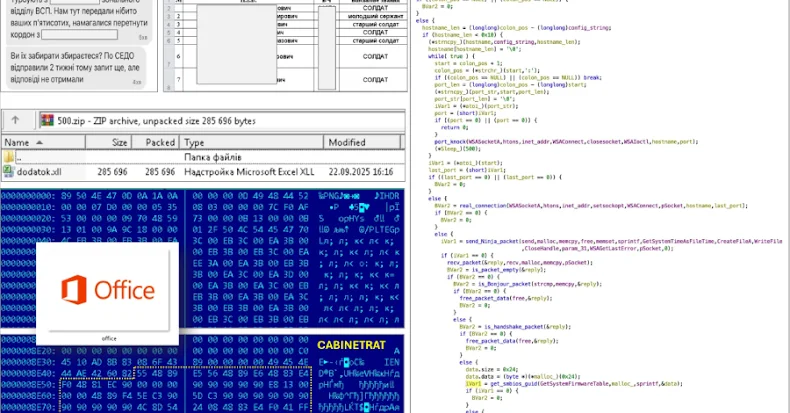Ukraine’s Computer Emergency Response Team (CERT-UA) has released a warning about CabinetRAT, a newly observed backdoor used in cyber espionage operations.
Attackers are now targeting government agencies, military entities, and critical networks across Ukraine. Their main goal is to steal sensitive information and maintain long-term access to compromised systems.
What CabinetRAT Does
CabinetRAT acts as a remote access trojan (RAT), designed to:
-
Establish stealthy persistence on infected machines
-
Provide attackers with full backdoor access
-
Steal sensitive documents and communications
-
Download and run additional malware
Because CabinetRAT is modular, operators can easily expand its functionality. This adaptability makes it especially dangerous in long-term espionage campaigns.
Delivery Tactics Observed
CERT-UA confirms that attackers deliver CabinetRAT through malicious email attachments disguised as government or military documents. Once opened, embedded macros or scripts launch the infection chain.
In addition, adversaries host payloads on compromised infrastructure, making it harder for defenders to trace the origin. As a result, attribution becomes more complex and detection takes longer.
Espionage Objectives
Unlike ransomware groups, CabinetRAT operators focus exclusively on intelligence collection. Their objectives include:
-
Extracting sensitive data from government systems
-
Monitoring secure communications between agencies
-
Maintaining persistence for extended surveillance
These tactics align with previous state-sponsored campaigns, reinforcing that espionage not financial gain drives the operation.
CERT-UA recommends immediate defensive actions. Organizations should:
-
Block malicious attachments by scanning for macros and unusual scripts.
-
Deploy endpoint detection and response (EDR) to stop persistence attempts.
-
Monitor network activity for suspicious outbound traffic linked to CabinetRAT C2 servers.
-
Enforce MFA and strict privilege controls to limit lateral movement.
-
Apply regular patching to reduce exploitable weaknesses.
Furthermore, sharing Indicators of Compromise (IOCs) with trusted partners will improve collective defense.
RATs as Espionage Tools
CabinetRAT fits into a broader trend where RATs dominate espionage operations. These tools are attractive because they:
-
Provide attackers with persistent footholds
-
Can be customized for different missions
-
Allow covert data exfiltration
Therefore, CabinetRAT highlights the growing reliance on stealthy backdoors as strategic cyber weapons.
CabinetRAT proves once again that adversaries are quick to innovate and persistent in their methods. By weaponizing phishing emails and deploying modular backdoors, they continue to infiltrate high-value networks in Ukraine.
Defenders must respond with layered security, vigilant monitoring, and rapid information sharing. Without these measures, espionage focused malware like CabinetRAT will continue to undermine critical infrastructure and national security.
FAQs
Q: What is CabinetRAT?
A: CabinetRAT is a backdoor malware that gives attackers persistent access to compromised systems, mainly for espionage.
Q: How is CabinetRAT delivered?
A: Attackers send malicious email attachments disguised as official documents, which trigger infection when opened.
Q: Who are the targets of CabinetRAT?
A: Ukrainian government agencies, military entities, and critical infrastructure organizations are primary targets.
Q: How can organizations defend against CabinetRAT?
A: Block suspicious attachments, deploy EDR, monitor traffic, enforce MFA, and share IOCs with trusted networks.











2 thoughts on “CERT-UA Issues Alert on CabinetRAT Backdoor Cyber Threat”